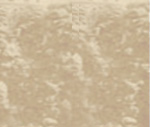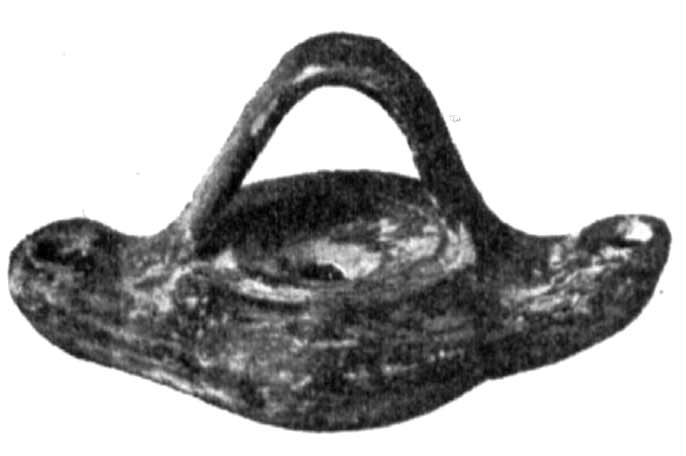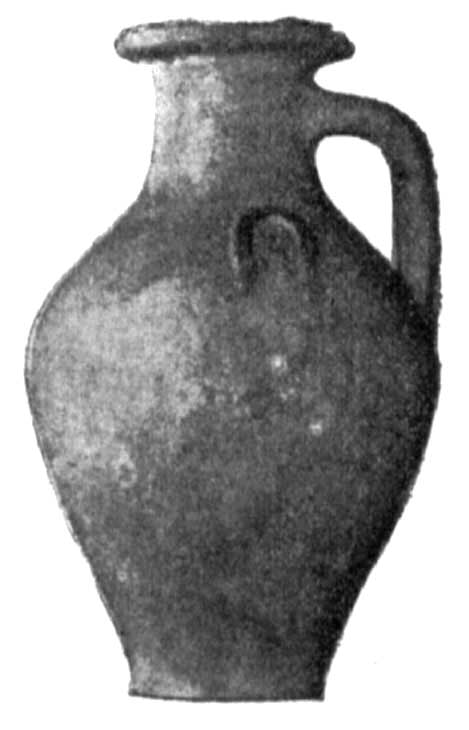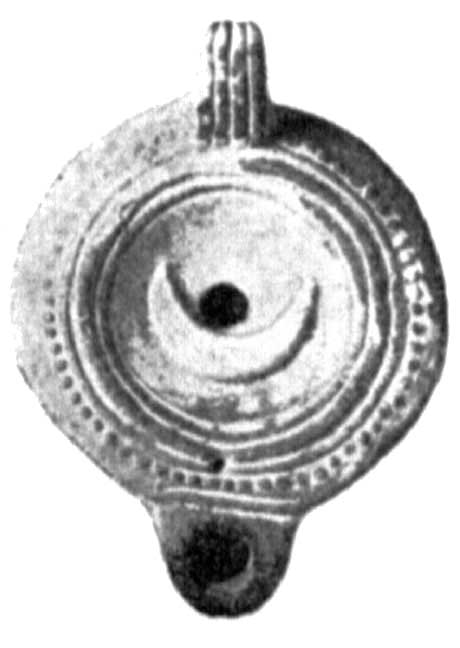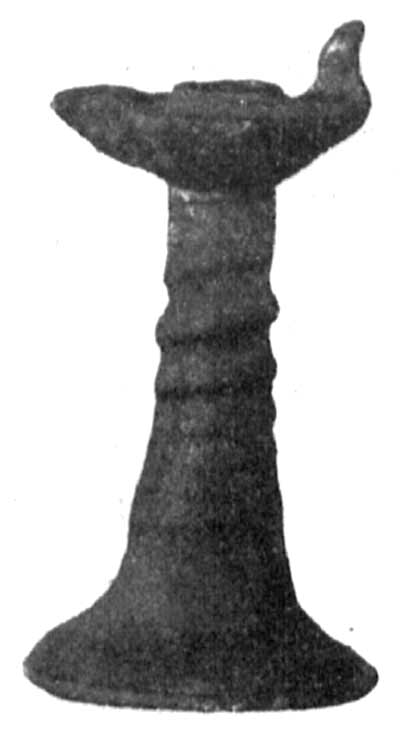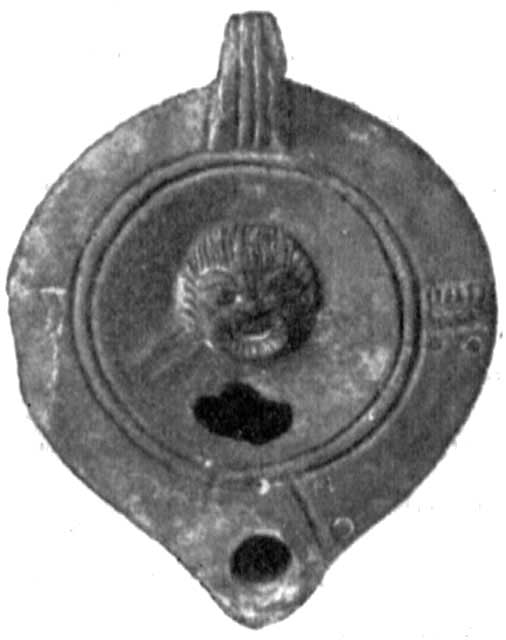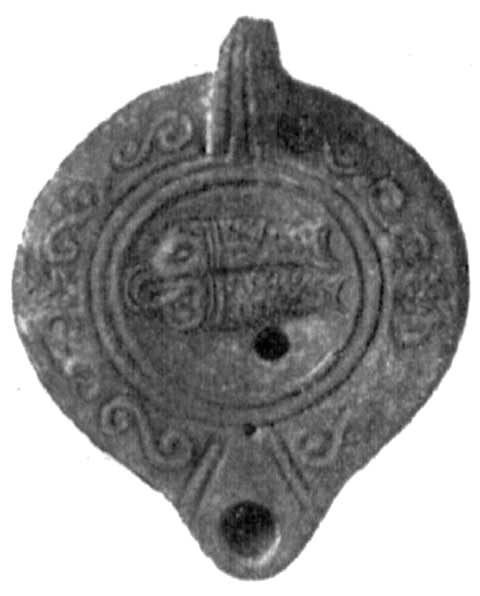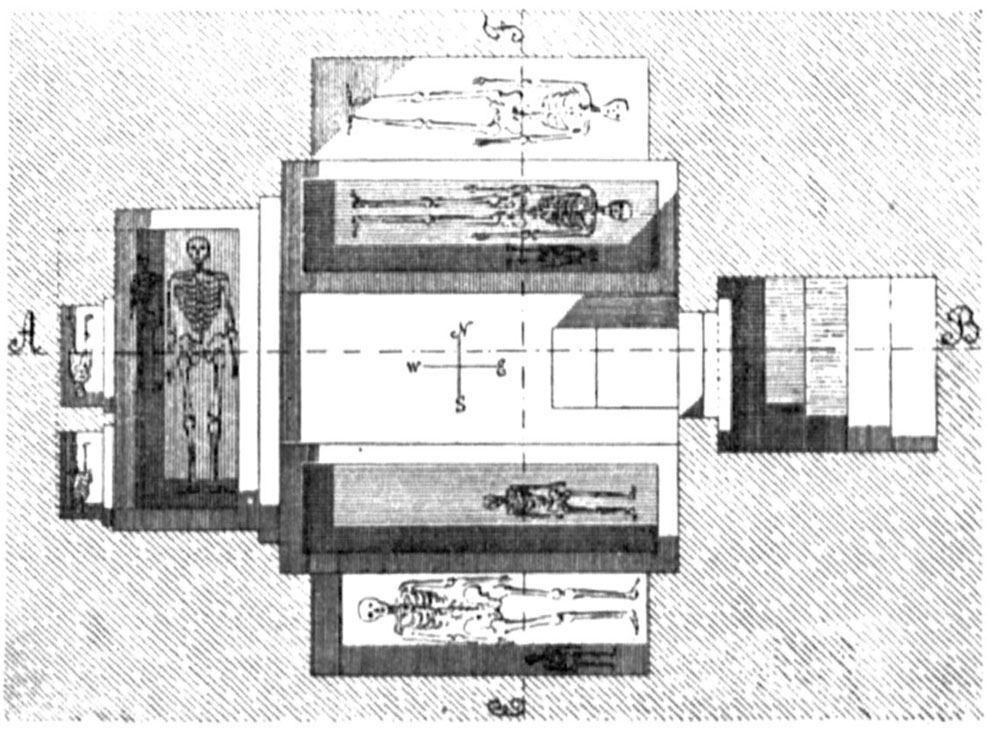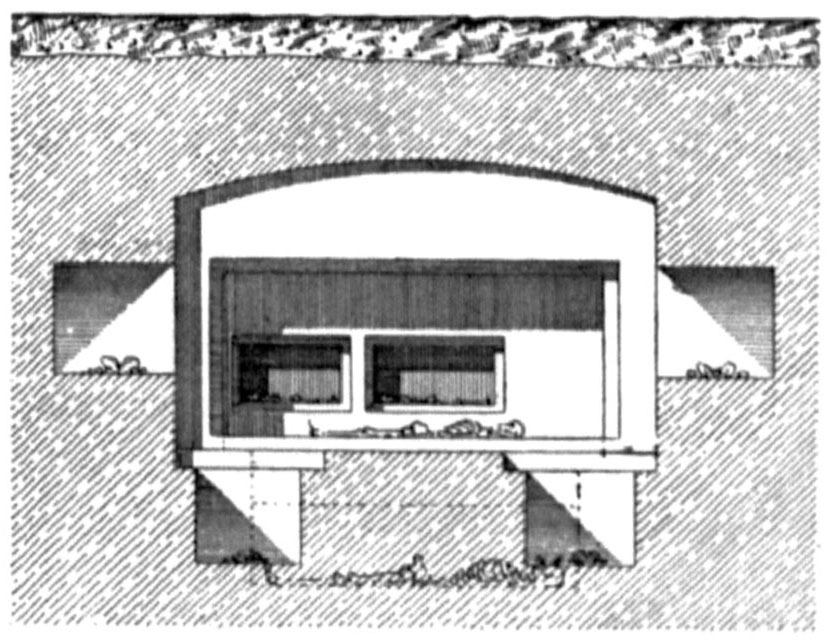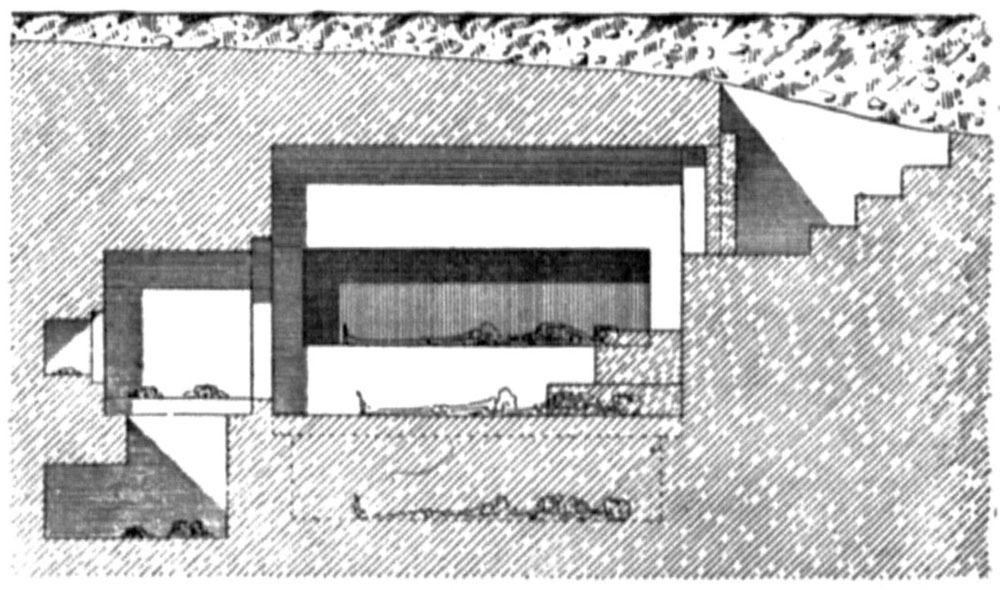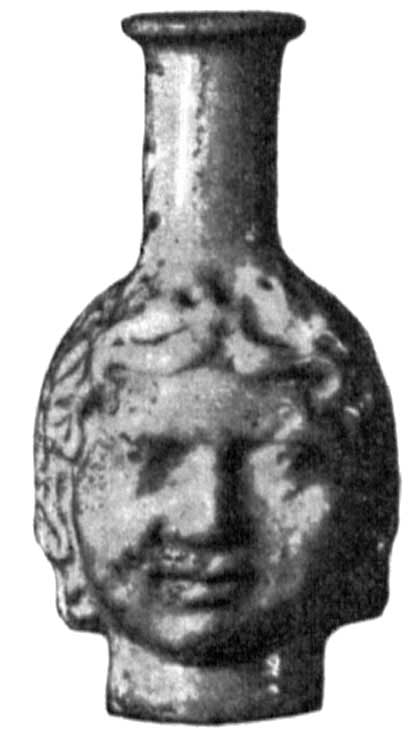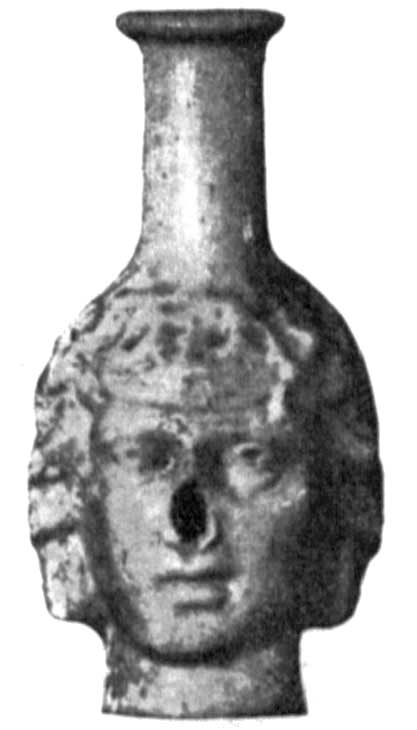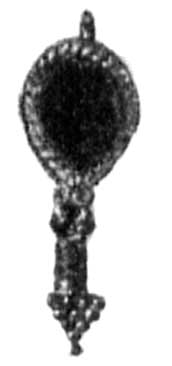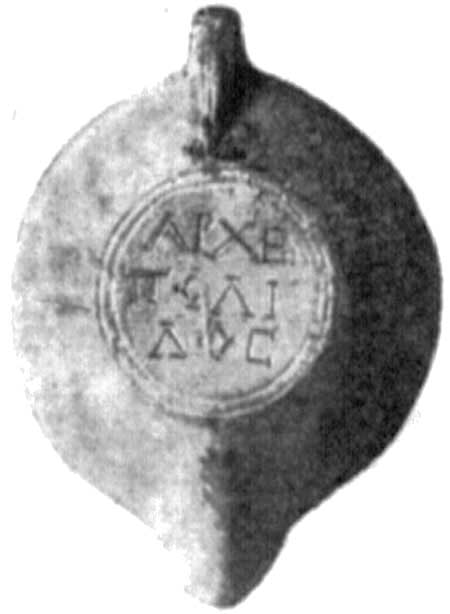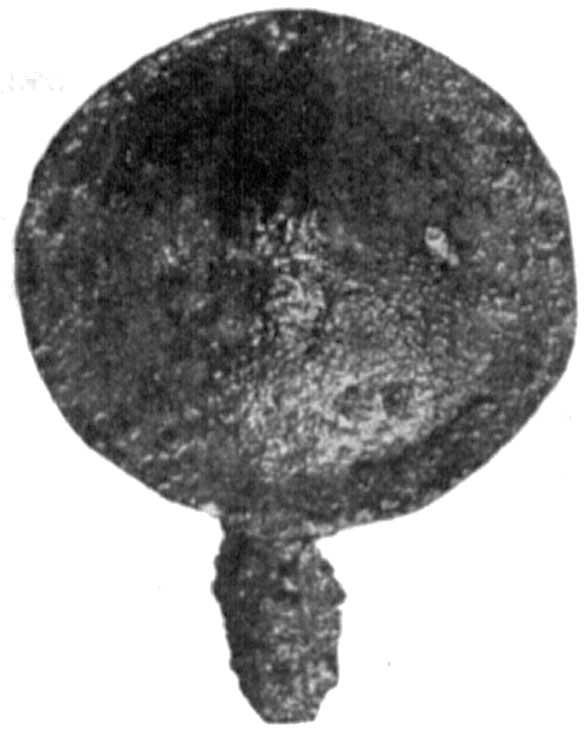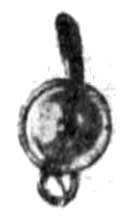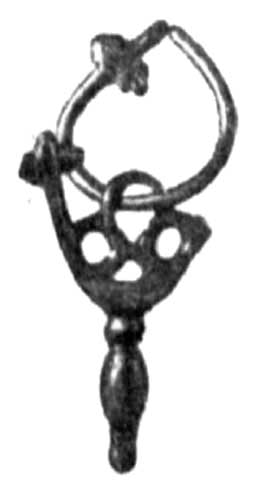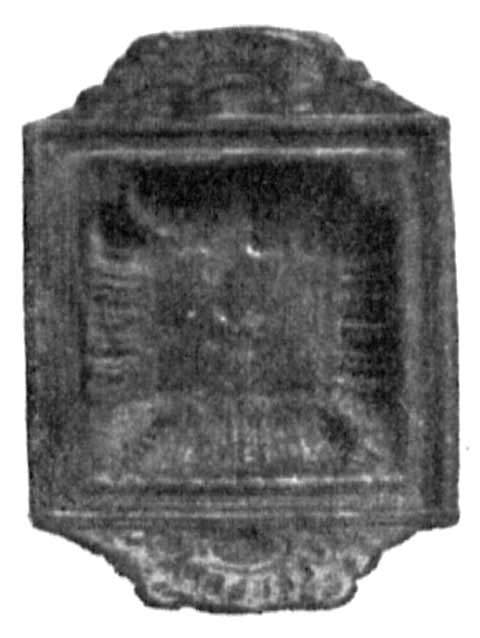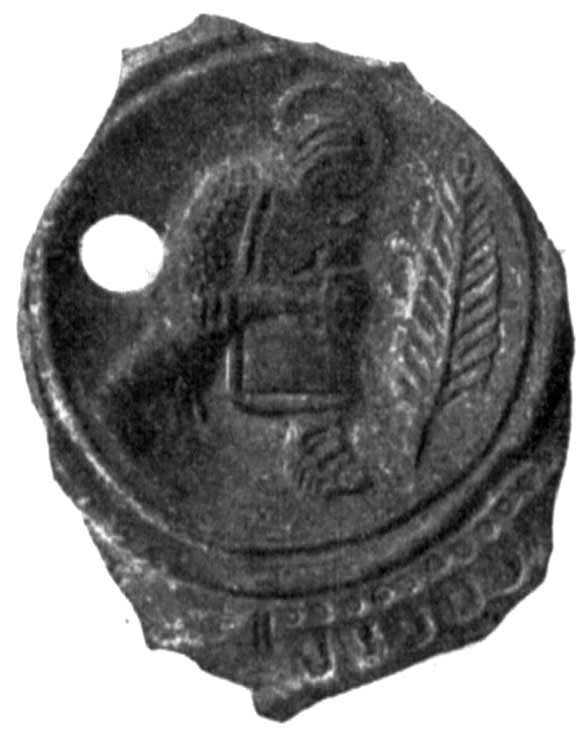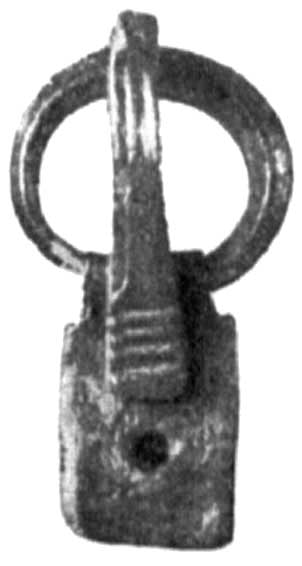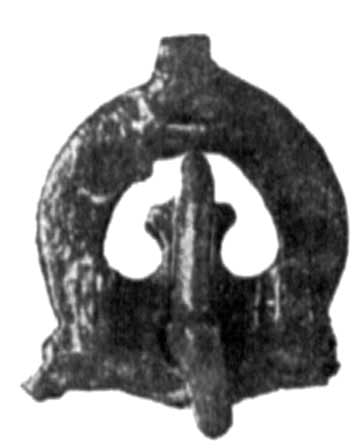1897 REPORT OF THE HEAD OF THE EXCAVATIONS IN CHERSONESOS MR K. K. KOSTSYUSHKO-VALYUZHINICH (PART 2)
IV. The continuation of the excavations of the necropolis
[23]
- This tomb was carved into bedrock; it was not covered and was plundered.
- Unfinished catacomb (2.5 m l<ong> and 2.15 m w<ide>).
- This carved into bedrock tomb penetrated from the top to the north-eastern corner of catacomb no. 814-й. It was found uncovered and unplundered.
- Similar tomb (2.15 m l<ong> and 1.4 m w<ide>) has slabs dividing it into two narrow tombs, which were neither covered nor plundered. It was located above the same catacomb.
- -819. Three car<ved> into bedrock tombs were not covered and were plundered.
- The catacomb (2.5 m l<ong>, 2.5 m w<ide>, 1.77 m h<igh>) has 3 bed-shaped niches and passageway (0.7 m х 0.7 m) to the e<ast>. It appeared plundered and filled with soil and fine stones.
- This carved into bedrock tomb was not covered and was plundered. It was located above catacomb no. 820.
- Similar tomb, without top slabs, plundered.
- The catacomb (2.5 m l<ong>, 2.15 m w<ide>, 1.85 m h<igh>) has 3 bed-shaped niches and passageway (0.7 m х 0.53 m) to the e<ast>. It appeared plundered and filled with soil and fine stone.
- This carved into bedrock tomb was not covered. It contained a skeleton with the head oriented to the s<outh>. At the foot, there was earthen<ware> single-handled pitcher, 0.2 m high.
- Underground tomb. There was single skeleton oriented with the head to the s<outh> and accompanied with gl<ass> balsamarium with narrow neck and wide flat bottom.
- This catacomb (3.9 m l<ong>, 3.55 m w<ide>, 1.75 m h<igh>) has 3 bed-shaped niches and passageway (0.7 х 0.7 m) to the e<ast>. Although there was a stone at the entrance, the catacomb appeared plundered.
- -828. Two catacombs, carved into bedrock, not covered and plundered, are located above catacomb no. 826.
- Underground tomb with skeleton of a child accompanied by: single-handled earthen<ware> juglet 0.1 m h<igh>, earthen<ware> lamp with relief image of bird pecking at a fruit, and broken bronz<e> bracelet.
- This catacomb (3.55 m l<ong>, 3.2 m w<ide>, and 1.75 m h<igh>) has 3 niches, supporting pillar in the middle, passageway (0.7 х 0.7 m) to the e<ast>, and no slab covering the entrance; it was covered with soil and plundered.

|
| Fig. 225 |
- Underground tomb with cremated skeleton. It contained twisted silv<er> earring and earthen<ware> spindle whorld.
- The same. Single-handled earthen<ware> juglet of the most popular type.
- The same. Ribbed earthen<ware> juglet without handles, and similar cup.
- The same. Gl<ass> flat-bottom balsamarium.
- The catacomb (3.55 m l<ong>, 3.2 m w<ide>, and 1.95 m h<igh>) has 6 niches in two tiers, pillar in the middle, and passageway (0.7 х 0.62 m) to the e<ast>. It appeared to be filled with soil and plundered. Removed soil contained: double-handled flat-bottom amphora; gl<ass> flat-bottom balsamarium; wide-neck bottle of dark gray glass, and child’s bronz<e> bracelet with blunt ends.
- This underground tomb was located above catacomb no. 835. The skeleton was oriented with the head to the s<outh> and accompanied with gl<ass> flat-bottom balsamarium.
Above catacomb (no. 835) and tomb (no. 836), there was compact mound of simple earthen<ware> pottery shards, of almost circular form, about 5 m in diameter and 0.75 m h<igh>.
- Underground tomb with child’s burial accompanied by: small bronz<e> wire brooch, broken, and 25 beads (1 circular, of rock crystal, 3 circular, of carnelian, 1 in the form of flat circle of bone, 16 circular, of multicolored glass, and 4 of blue glass of the same form, connected in fours).
- Underground tomb. The skeleton was oriented with the head to the s<outh>; at the head, there were: heavily damaged bronz<e> coin of, probably, Amisos or Sinope, and earthen<ware> sinker for fishing net in the form of truncated pyramid.

|
| Fig. 226 |
- -843. Five undergr<ound> tombs that were disturbed when making burials in a later period. These appeared to contain nothing.
- Crushed single-handled earthen<ware> urn; it appeared to contain cremated bones only.
- -847. Three three-handled earthen<ware> urns. One of them is unbroken and contained: gl<ass> flat-bottom balsamarium, ir<on> finger-ring, damaged by fire, and knife blade. Amidst cremated bones that fell out of 2 other, crushed urns, there were 3 oval sil<ver> beads.
- Plundered underground tomb.
- The same. The skeleton was oriented with the head to the s<outh>; above it, there was earthen<ware> bowl.
- Underground tomb with cremated skeleton. Earthen<ware> bowl containing earthen<ware> lamp with 2 holes for wick located opposite to each other, and arc handle on top similarly to that of the baskets
(Fig. 226)
.
- Underground tomb. Earthen<ware> plate and whetstone without hole.
- The same, with skeleton of a child. Pair of bronz<e> bracelets with blunt ends.
- This plundered underground tomb was located partly above catacomb no. 835.
- The same. The skeleton was oriented with the head to the s<outh> and accompanied with handleless earthen<ware> juglet and bronz<e> coin of Cheronesos, greatly damaged by oxidizing (Burachkov, <Op. cit., pl.> XVI, 102).
- This tomb was carv<ed> into bedrock and covered with two slabs. At the head of the skeleton oriented to the s<outh>, there were gl<ass> narrow-neck flat-bottomed balsamarium and bronz<e> coin of some Roman emperor of the early fourth century AD.
- Underground tomb with child’s burial accompanied with pair of bronz<e> bracelets with blunt ends.
- This carved into bedrock tomb was not covered and was plundered.
- The same. In the north end, there was single-handled earthen<ware> urn that contained cremated bones only. This typical urn of the Roman period was put into the plundered ancient Greek tomb.
- -860. Two adjacent tombs, laid of big roof tiles, one oriented from n<orth> to s<outh> and another from w<est> to e<ast>, both were destroyed and plundered. Only one roof tile remained, with badly preserved stamp. The northern tomb contained a fragment of red clay narrow-neck handleless vessel.
- Plundered underground tomb.
- The same. The skeleton was accompanied with single-handled earthen<ware> cup and 12 glass elongated beads of blue color.
- The same.The skeleton was oriented with the head to the s<outh> and was accompanied with black slip plate, broken into smallest pieces, and grooved vase.
- This laid of big roof tiles child’s tomb was destroyed.
- -866. Two carved into bedrock tombs were not covered and were plundered.
- This tomb (2.15 m l<ong>, 0.7 m w<ide>, 1.05 m h<igh>) was carved into bedrock and covered with 4 slabs. There were 2 male skeletons with the heads to the s<outh>. At the legs, in the north-eastern corner, there were earthen<ware> single-handled juglet and cup, and on the north-western corner there were 2 earthen<ware> lamps (one plain and another with relief image of jumping lion); at the waist, 2 ir<on> knife blades; and finally, at the head, 2 crushed glass bottles and bronz<e> coin of Caucasian Caesarea.
- Underground tomb with skeleton of a child accompanied with black slip earthen<ware> single-handled juglet, decorated with brow rosette, and broken terracotta mask of Demeter, of rough workmanship.
- The same. The skeleton of a child was accompanied with chiseled bone ring and broken bronz<e> bell.
- -871. Two underground tombs. Single skeletons appeared to be not accompanied by grave goods.

|
| Fig. 227 |
- The tomb was laid of big roof tiles, all discovered fragmented. Black slip earthen<ware> plate with initials, probably of the owner, scratched on its bottom, was leaned to the outer side of the tomb.
- This tomb was carved into bedrock. At the bottom, there were cremated bones, accompanied with damaged by fire single-handled earthen<ware> cup. Above, there was child’s skeleton, with the head to the s<outh>, accompanied with single-handled earthen<ware> juglet and cup standing at the legs; at the head, there were: 2 gold wire earrings with hanging ball
(Fig. 227)
; damaged green paste pendant in the form of bearded man wearing chlamys; round ribbed bead of the same paste, and bronz<e> coin of Chersonesos (Burachkov, <Op. cit., pl.> XVI, 118), undoubtedly placed to the mouth, as copper oxide colored the child’s front teeth.
- Similar grave that was not covered and was plundered.
- -877. Three crushed earthen<ware> urns (two with one handle and one with three handles). It appeared to contain nothing but cremated bones.
- Underground tomb with skeleton accompanied by single-handled earthen<ware> cup.
- This carved into bedrock tomb was not covered and was plundered.
- Underground tomb contained broken grooved black slip earthen<ware> vase, of good workmanship, and single-handled cup of simple clay, which form differed from that of the cups dated to the Roman period.

|
| Fig. 228 |
- This tomb was laid of stone slabs including 4 tablets with quadrangular holes from the ancient Greek gravestones
[24]
. In the tomb, there were 3 earthen<ware> urns (only one of them remained; it was closely covered with lead lid); all these urns appeared to contain nothing but cremated bones. These urns were of beautiful form, with one big vertical handle and two small horizontal handles which were decorative
(Fig. 228)
.
- -887. Six underground tombs, each contained single skeleton and no grave goods. The last one was located above the eastern corner of catacomb no. 888.
- The catacomb (3.2 m l<ong>, 3 m w<ide>, and 1.75 m h<igh> ) has 3 niches and passageway (0.62 х 0.65 m) to the n<orth>-e<ast>. The soil layer above the catacomb was 0.75 m thick. Side niches are of usual form, the middle one, that faces the entrance, is carved like an arch 0.8 m high. As the bedrock in this area of the necriopolis is friable and with clay streaks, they need a special door frame for the entrance, which was carefully carved of solid slab of more strong rock. A number of splinters fell out of the catacomb ceiling, especially from its south-eastern corner, above the left niche, where a small hole developed, that communicated with tomb no. 887. These splinters crushed a number of earthen<ware> vessels and two glass bottles. Bedrock footing of the catacomb consisted of hard clay; the entrance was covered with stone slab, so the soil did not penetrate еще he catacomb, and only some soil and fine stone fell throught the said hole in the south-eastern corner, above the left niche. There were 5 skeletons on the floor of the catacomb: man’s to the right from the wall, with the head to the exit, and 4 skeletons (starting from the door) of a man, a child, a woman, and another man, oriented with the legs towards the first one and the heads to the s<outh>-e<ast>. Three shelves housed 4 skeletons, namely: on thу right one, there was woman, with the head to the n<orth>-e<ast>; on the central, two children, with the heads to the s<outh>-w<est>; and on the left one, woman, with the head to the n<orth>-e<ast>. Hence, there were 9 skeletons total; they were placed into coffins, according to big i<ron> tetrahedral spikes with fragments of wooden boards that remained in situ. The excavation started from the right side, from the skeleton laying with the head to the exit. According to the skull, it was senile person, as no trace of teeth remained in the upper jaw, and only 4 thin teeth preserved in the lower jaw; all other parts of jaws were absolutely smoothed. The bones and wooden fragments fell into pieces, if touched. Above the head of the skeleton, under the ceiling, on a projection of bedrock, there was earthen<ware> lamp with relief image of crescent that is found for the first time

|
| Fig. 229 |
(Fig. 229)
. At the head, there were earthen<ware> bowl, 2 single-handled juglets (one ribbed) and single-handled cup; at the waist, there were pointed-bottom double-handled amphora, ir<on> knife blade, bronz<e> buckle, slab of green marble with the edges aslant on one side, earthen<ware> lamp with relief image of rosette with 24 petals, and 2 bronz<e> coins of Chersonesos (Burachkov, <Op. cit., pl.> XVI, 109 and 114); near the legs, there were 2 earthen<ware> cups (plain with single handle and handleless with grooves). The woman’s skeleton in the right niche was accompanied with: at the head, single-handled earthen<ware> cup that stood in the very corner, gold spectacles-shaped leaf with stamped image of eyes, similar oval leaf with stamped image of clenched lips; at the waist, 2 bronz<e> coins of Chersonesos (Burachkov, <Op. cit., pl.> XVI, 109). Two skeletons of children in the middle niche were accompanied with: at the heads, g<old> leaf to cover eyes; oval g<old> leaf for mouth; 2 g<old> impressions of coins with illegible images, that were probably squeezed from the third century AD colonial coins; at the waist, narrow-neck gl<ass> bottle with waist; 2 single-handled earthen<ware> cups, and 2 bronz<e> coins of Chersonesos (Burachkov, <Op. cit., pl.> XVI, 108). Above the bed, on the projection of bedrock, there were: 2 earthen<ware> lamps, standing one on the other (the first of light clay, of unusual light weight, with relief image of rosette with 24 petals; the second of red clay, densely covered by soot, with rough, limp relief image of lion, stepping left). At the head of the woman’s skeleton in the left niche, there were: double-handled earthen<ware> cup, broken by piece of bedrock that fell from above; pair of g<old> earrings in the form of openwork hemisphere, with convex oval garnets, inserted in the middle, and g<old> pyramid pendants of 5 globules each, covered with granulation; toothed silv<er> medallion pendant; g<old> impression of coins, that was probably squeezed from the third century AD colonial coin; at the waist, there were 2 bronz<e> coins of Chersonesos (Burachkov, <Op. cit., pl.> XVI, 106 and 112). Above the bed, at the foot, on the projection of bedrock, there was light-clay, very light in weight lamp, with fine relief image of a girl and satyr standing, facing each other, and gesticulating

|
| Fig. 230 |
(Fig. 230)
Below, on the bottom, there were three lines with the maker’s name
 (Fig. 231)
. The skeleton of a man, which was most close to the exit, laid on the floor with the head oriented to the s<outh>-e<ast>; at the head, there were: earthen<ware> bowl; single-handled
(Fig. 231)
. The skeleton of a man, which was most close to the exit, laid on the floor with the head oriented to the s<outh>-e<ast>; at the head, there were: earthen<ware> bowl; single-handled

|
| Fig. 231 |
earthen<ware> juglet; and single-handled earthen<ware> bowl; at the waist, bronz<e> needle, broken into pieces; 2 bronz<e> fishhooks; ir<on> knife blade; 2 pieces of flint, for a fire-steel; bronz<e> belt buckle; ir<on> finger-ring, destroyed by rust; and bronz<e> coin of Chersonesos (Burachkov, <Op. cit., pl.> XVI, 112). Nearby, at the skeleton of a child, there were: at the head, g<old> oval leaf for covering mouth, and, at the waist, 2 oval carnelians with carved images of standing Zeus on one of them and eagle catching rooster on the other; and bronz<e> coin of Chersonesos (Burachkov, <Op. cit., pl.> XVI, 118). Nearby, at the skeleton of a woman, there were: at the head, crushed bottle of thin glass, covered with ribs; oval g<old> leaf for covering mouth; silv<er> hair pin; gold impression of coin, with illegible image; 5 round carnelian beads; 1 pear-shaped bead, of rock crystal; 2 beads in the form of flat circles; a number of jet beads that fell into pieces if touched. At the waist, there were: sil<ver> finger-ring with oval carnelian, where rooster is carved; bracelet, that consisted of 8 pierced gl<ass> beads in the form of ribbed hemispheres, with two holes each; and bronz<e> coin of Chersonesos (Burachkov, <Op. cit., pl.> XVII, 114). Near the legs, there were earthen<ware> lamp with relief image of rosette with 24 petals and 2 single-handled earthen<ware> cups. The skeleton of the man, most close to the western wall, was accompanied with earthen<ware> bowl and single-handled cup near the head. At the waist, there were ir<on> blade and blade and fragment of handle of straight dagger, where particles of wood and silver round head of fastening part remained. Lower than the dagger, there was ir<on> sword blade, heavily damaged by rust. At the same place, there were: single-handled earthen<ware> cup with traces of design, roughly made with yellow pigment (3 flowers and handled basket in between of them); ribbed earthen<ware> lamp; ir<on> finger-ring, destroyed by rust; belt buckle of low-grade silver, with gold badge with stamped wreath and emerald inset in the centre

|
| Fig. 232 |
(Fig. 232)
; globular gl<ass> bottle (0.12 m h<igh>), with narrow neck, crushed by fallen piece of bedrock, with inscription
 around, and 2 bronz<e> coins from Chersonesos (Burachkov, <Op. cit., pl.> XVI, 113 и 114). At the foot, there was a fragment of leather low heel with finely hammered nails having round conical heads.
around, and 2 bronz<e> coins from Chersonesos (Burachkov, <Op. cit., pl.> XVI, 113 и 114). At the foot, there was a fragment of leather low heel with finely hammered nails having round conical heads.
- -892. Four carved into bedrock tombs were not covered and were plundered.
- This tomb (2.15 m l<ong>, 0.7 m w<ide>, and only 0.17 m d<eep>) was carved into bedrock; it contained woman’s skeleton, with the head to the s<outh>. At the head, there were: g<old> pendant in the form of Eros holding beautiful mask of a man in his raised right hand, and butterfly in his lowered left hand

|
| Fig. 233 |
(Fig. 233)
; 6 beads (2 round, plain, of rock crystal, 1 round, ribbed, of carnelian, 2 carnelian in the form of tetradecahedrons, and 1 elongated carnelian); bronz<e> coin of Chersonesos dated to the age of Mithridates Eupator
[25]
.
- -895. Two plundered underground tombs.
- This carved into bedrock tomb was not covered with slabs and was plundered.
- -898. Two plundered underground tombs.
- This carved into bedrock tomb was not covered and was plundered.
- This catacomb was carved into bedrock very carelessly; it is of irregular form, 3.35 m l<ong> and 2.15 m w<ide>, with rough ceiling, which is maximum 1.95 m high above the footing; there are 3 niches and entrance from the e<ast>. In the catacomb, there are traces of water that penetrated inside; it reached the beds and left wet crust of hardened silt on the wall and floor in this place. Although skeletons on shelves were articulated, they perished if touched. In total, there were 16 skeletons: 5 in the niche to the right from the entrance, 8 in the middle one, and 3 in the left one. The most close to the entrance skeleton in the middle niche has greatly deformed skull. In each niche, skeletons laid with the heads to opposite sides, i. e. to the narrow walls of the niche, and were fenced with stones in the direction of the catacomb in order to protect them from falling out. The skeletons in the right niche were accompanied with: fragment of ill-baked earthen<ware> pot; bronz<e> neck ring, broken into pieces; and greately damaged bronz<e> coin of one of the fourth century AD Roman emperors. In the middle niche, there were: in the s<outh> corner, earthen<ware> lamp with high flaring foot

|
| Fig. 234 |
(Fig. 234)
, plain earthen<ware> lamp; and bronz<e> coin, probably of Theodosius the Great or one of his sons. In the middle of this niche, there were bronz<e> bracelet with blunt ends and ir<on> finger-ring. In the n<orth> corner, there were: earthen<ware> lamp with rough, limp image in relief of Eros walking right, and double-handled earthen<ware> cup. In the w<est> corner of the left niche, there were 2 plain earthen<ware> lamp and, in the middle, bronz<e> belt buckle. When the layer of clay was removed from the floor, rotten human skeletons appeared there; they were accompanied with the following artifacts: 2 single-handled earthen<ware> juglets; 3 earthen<ware> cups (one with two handles and 2 single-handled; one of the latter bears traces of pattern made roughly, by white pigment); double-handled earthen<ware> vase; 4 plain earthen<ware> lamps; 2 earthen<ware> lamps with relief image of a bad, of rough workmanship, and comic face with open mouth and long hair
(Fig. 235)
; 3 g<old> impressions of coins (two small portraying bust of a Roman emperor facing right and standing figure, and one big with traces of a face to the right); 3 bronz<e> coins from Chersonesos (Burachkov, <Op. cit., pl.> XVI, 101 (?), 114 и 120).

|
| Fig. 235 |
Undoubtedly, many skeletons were placed in these niches in the later Roman periood, which is proved by the number of them (8 skeletons on the cenral bed, with the heads oiented in opposite directions), deformed skull of one of the skeletons, and, finally, by Roman coins of the fourth century, whereas the coins that accompanied the skeletons laying on the floor, under the layer of clay, date to the second century AD.
- This tomb was carved into bedrock; it was not covered with slabs and was plundered.
- The catacomb (3.9 m l<ong> and 2.85 m w<ide>) has 3 niches, pillar in the centre, and entrance from the east; the ceiling collapsed, so the catacomb was filled with soil and stone; it was plundered. A huge number of disarticulated bones laid on the floor and on the beds. The finds uncovered when removing the soil: chiseled bone clasp
[26]
; red clay lamp with relief image of two fishes bound together at the heads
(Fig. 236)
; 5 plain earthenware lamps (3 very rough); bronz<e> child’s earring; bronz<e> bell clapper; tablet of bright marble (0.11 х 0.065 m), with the edges aslant on one side, similarly to the one uncovered from catacomb no. 888; convex oval carnelian with carved into its surface figure of woman holding trident in the left hand and amphora in the lowered right hand, and bronz<e> coin of the emperor Theodosius the Great (378-395).

|
| Fig. 236 |
- This catacomb (3.9 m l<ong>, 3 m w<ide>, and 1.85 m h<igh>) has 4 niches (one in n<orth> wall, one in w<est> wall, and two in the s<outh> wall) and semicircular entrance facing e<ast> (0.62 m high). The catacomb is carved with great care, with specially inserted door-frame made of solid slab, similarly to catacomb no. 888. In the catacomb, on the left side, there were: small stone slab, dressed from every side, and sawen-along oak beam, 1.6 m long and 0.27 m in diameter, which were probably used as a devise to put the coffins through the round hole. The skeletons could be seen in the niches only, as the floor was covered with a layer of hardened silt (similar to catacomb no. 900). In total, there were 7 skeletons on the shelves: 1 on the right shelf at the entrance, 3 on the shelve opposite to the entrance, 1 on the shelf most close to previous from the left, and 2 on the next shelf to the left. Near the skeleton of a woman in the right niche, oriented with the head to the e<ast>, there were: at the head, ribbed earthen<ware> lamp with inscription ХРУ on top
[27]
; g<old> pendant for an earring, in the form of wire tube with hook; oval carnelian, with rough incised image of a man, stepping right; 21 beads (5 amber, in the form of flat circles; 2 of blue glass, in the same form; 2 elongated, also of blue glass, and12 ribed, round, of brown glass). At the waist, there was ir<on>finger-ring, at the feet, flat-bottom gl<ass> bottom and plain earthen<ware> lamp. Near three skeletons in the middle nich, that were oriented with the heads to the n<orth>, there were: at the heads, 3 single-handled earthen<ware> cups; single-handled earthen<ware> juglet; plain earthen<ware> lamp; 3 g<old> impressions of coins with image of lion, stepping right, and busts of unknown Roman emperor and empress, facing right; oval carnelian, for a medallion, with carved wish EYTYXEC; multitude of various beads (52 lentil-shaped, of blue glass; 9 elongated, of red paste; 8 elongated, of black paste; and 68 amber, in the form of flat circles of different size); 5 amber padlock-shaped pendants. At the waist: plain earthen<ware> lamp; 2 ir<on> knife blades; bronz<e> belt buckle; ribbed gl<ass> bracelet without any trace that its ends joint together; child’s bronz<e> bracelet with pointed ends; plain silv<er> finger-ring, and date stones, completely decayed. At the lefs: 4 plain earthen<ware> lamps; miniature single-handled earthen<ware> juglet; and earthen<ware> bowl. In the extreme left niche, there was child’s skeleton, with the head to the w<est>, accompanied with: at the head, miniature earring of gold wire and 85 beads (3 round, of multicolored paste, in glass shard technique; 2 round, ribbed, of green paste; 25 elongated, plain, of brown glass; 12 elongated, ribbed, of blue glass; 9 elongated, plain, of blue glass; and 34 round, plain, of multicolored glass). At the waist, there were: child’s bronz<e> bracelet with obtuse ends; plain bronz<e> finger-ring; and bronz<e> snake-shaped ring. In the next niche on the left, there were two woman’s skeletons, with the heads to the e<ast>, accompanied with: at the ehad, oval bronz<e> leaf for covering mouth, plated with thin layer of gold; 2 bronz<e> earrings, either with blue glass bead put on it; bronz<e> coin of the emperor Valentinian I (364-375), and 64 beads (14 square, of blue glass; 7 of the same glass, in the form of plain tubes; 16 similar, ribbed; and 27 round, plain, of multicolored glass). At the waist: 2 bronz<e> bracelets with obtuse ends; ir<on> key, destroyed by rust; 2 plain earthen<ware> lamps; and seeds of watermelon and melon. At the feet: double-handled earthen<ware> cup; gl<ass> bottle with pointed spout (similar to the one uncovered from tomb no. 188); single-handled earthen<ware> pot, ill-fired; rough earthen<ware> lamp; fragment of bone spoon, and hen’s egg shell. Below, in a cavity in bedrock, there was lamp of sheet copper, of common form, that is interested because of the wick that went from one hole to the other and preserved well within the lamp. After the clay layer was removed, rotten human bones and grave goods appeared on the floor of the catacomb. There were: 2 oval gol<d> leaves, with impressed images of eyes, for covering eyes of a child, that replaced usual

|
| Fig. 237 |
type of leaves in the form of spectacles; oval gol<d> leaf for covering mouth of a child; 2 gold wire earrings; earring of thin gold badge in the form of hemisphere with a hook soldered to it
[28]
; 4 flat-bottom gl<ass> bottles; 2 flat-bottom gl<ass> balsamaria; single-handled earthen<ware> cup, with traces of an inscription, carelessly made with white paint; solid twisted bronz<e> bracelet, with insignificant traces of gilding; 3 ir<on> knife blades, one with fragment of wooden scabbard; 3 earthen<ware> single-handled cups; 2 earthen<ware> bowls; chiseled b<one> handle; 4 plain earthen<ware> lamps, of rough workmanship; bronz<e> finger-ring key, discovered on a finger bone
(Fig. 237)
; pierced bead of gray paste with white stripes; 9 round flat beads of blue glass; one silv<er> colonial coin, and 6 bronz<e> coins of Chersonesos (Burachkov, <Op. cit., pl.> XVI, 99, variant, 106, 108 and 110).
- -905. Two carved into bedrock tombs were not covered and were plundered.
- -907. Two these underground tombs were plundered.
- Earthen<ware> urn in the form of double-handled pointed-bottom amphora. Inside, there were bones of a baby that were not cremated. The type and good quality of this urn allows me to date it to the Greek period.
- This catacomb (3.20 m l<ong>, 2,50 m w<ide>, and 1.75 m high) has 2 niches in the right and west walls and entrance to the east that was not covered with slab (0.62 х 0.66 m). Catacomb appeared to be covered with soil and plundered. The soil was removed and sieved, but contained no finds.
- Plundered underground tomb.
- This carved into bedrock tomb was not covered with slabs and was plundered.
- Underground tomb. The skeleton laid with the head to the s<outh>; at the head, there were bronz<e> coin of Chersonesos (Burachkov, <Op. cit., pl.> XVI, 103) and single-handled earthen<ware> pitcher.
- This carved into bedrock tomb was 1.75 m d<eep> (similarly to tomb no. 544) and had 2 niches in its long walls, at the footing, either 0.70 m deep. Apart from the bones laying in disorder, there was plain earthen<ware> lamp located in soil in the passageway between the niches.
- Underground tomb. At the head of the skeleton, there was bronz<e> coin of Chersonesos (Burachkov, <Op. cit., pl.> XVI, 109).
- Plundered underground tomb.
- -917. Two carved into bedrock were located above catacomb no. 903; they were not covered with slabs ad were plundered.
- Plundered underground tomb.
- The same. The skeleton with the head to the s<outh> was accompanied with double-handled earthen<ware> juglet and earthen<ware> saucer.
- -924. Five tombs were carved into bedrock carefully, but not deeply; they were not covered and were plundered.
- Plundered underground tomb.
- This tomb was carved into bedrock. The skeleton was accompanied by plain earthen<ware> lamp.
- Plundered underground tomb.
- -930. Three tombs similar to nos. 920-924.
- Plundered underground tomb.
- This tomb was carved into bedrock. At the head of the skeleton oriented to the south, there was bronz<e> coin of autonomous Chersonesos with image of the head of Heracles on one side and gnarled club on the other (Burachkov, <Op. cit., pl.> XV, 56?).
- -934. Two carved into bedrock tombs were not covered with slabs and were plundered.
- The catacomb (2.30 m l<ong>, 2.15 m w<ide>, and 1.68 m h<igh>) has 1 niche in its north wall and entrance from the east (0.62 х 0.62 m), carefully blocked with a slab. On the floor at the west wall, there were 3 skeletons with the heads oriented to the north, and in the niche there were 2 skeletons with the heads to the w<est>. Despite the skeletons were articulated, iron nails of coffins were in situ, and the entrance slab was closely fitted, there was neither coins, nor pottery, nor even shards in this catacomb.
- The catacomb (1.75 m l<ong>, 1.42 m w<ide>, and 1.55 m h<igh>) without niches and with entrance (0.70 х 0.62 m) on the e<ast> appeared uncovered, filled with soil, and plundered. The soil removed from it contained: single-handled earthen<ware> juglet; single-handled earthen<ware> cup; 4 elongated beads of green glass; 2 round beads of blue glass, and flint fragment.
- Double-handled earthen<ware> urn. Apart from cremated bones, it appeared to contain narrow-neck handleless earthen<ware> vessel.
- -940. Three carved into bedrock tomb were not covered with slabs and were plundered.
- This tomb was carved into bedrock. The skeleton was oriented with the head to the west and was accompanied with bronz<e> coin of some Greek colony, uninterpretable, and black slip earthen<ware> plate with letters АГА scratched on its bottom.
- The same. The skeleton was oriented with the head to the e<ast> and accompanied with bronz<e> coin of autonomous Chersonesos (Burachkov, <Op. cit., pl.> XIV, 11-12?, but of bigger size) and black slip earthen<ware> plate with Greek letters scratched on its bottom.
- -946. Four carved into bedrock tombs were not covered with slabs and were plundered. In adjacent tombs nos. 943 and 944, the skeletons laid with the heads oriented toward each other.
- Plundered underground tomb.
- This tomb was carved into bedrock; it was not covered and was plundered.
- The same. The skeleton was oriented with the head to the s<outh> and accompanied with earthen<ware> single-handled juglet.
- Unfinished catacomb. Only corridor and entrance were carved.
- -952. Two carved into bedrock tombs were not covered and were plundered.
- This tomb was laid of 4 roof tiles without marks with the names of astynomoi. Inside, there were earthen<ware> urn, similar to the one uncovered from tomb no. 881, and black slip earthen<ware> plate with inscription
 scratched on the outer surface of its wall. The urn contained cremated bones and ir<on>finger-ring, greatly damaged by fire.
scratched on the outer surface of its wall. The urn contained cremated bones and ir<on>finger-ring, greatly damaged by fire.
- This carved into bedrock tomb was not covered and was plundered.
- Plundered underground tomb.
- This carved into bedrock tomb was not covered and was plundered.
- Underground tomb. The skeleton of a child was accompanied by bone stick with a hole that was used as a handle for bronze bell.
- -959. Two carved into bedrock tombs were not covered and were plundered.
- -961. 2 similar tombs were located close to each other, composing right angle; they were not covered and were plundered.
- This tomb was carved into bedrock. The skeleton of a woman was oriented with the head to the s<outh> and accompanied by: big expandable bronz<e> bracelet with pendant in the form of toothed bronz<e> medallion with wide eyelet put on it, and details of mortise lock, namely: bronz<e> plate with hole for key, straight bronz<e> key, and bronz<e> part.
- This tomb was carved into bedrock. The skeleton was accompanied by earthen<ware> single-handled juglet and plain earthen<ware> lamp.
- -966. Three plundered underground tombs.
- -968. Two carved into bedrock tombs, either with single skeleton and one plain earthenware lamp.
- This carved into bedrock tomb was not covered and was plundered.
- Plundered underground tomb. Above, there was crushed earthen<ware> urn in the form of Greek amphora (similar to the one uncovered from tomb no. 908) with bones of a baby that were not cremated.
- Plundered underground tomb.
- -974. Three carved into bedrock tomb were not covered with slabs and were plundered.
- Plundered underground tomb.
- Similar tomb. At the head of the skeleton, on the south side of the tomb, there was narrow-neck handleless earthen<ware> vessel.
- Plundered underground tomb.
- This tomb was carved into bedrock. Child’s skeleton was accompanied with glass ring and 7 beads of blue glass with white eyes.
- This tomb was carved into bedrock and closely covered with 2 slabs. At the child’s skeleton with the head to the w<est>, there were: at the head, bronz<e> coin of Chersonesos (Burachkov, <Op. cit., pl.> XVI, 109) and ribbed earthen<ware> lamp; at the waist, single-handled earthen<ware> cup and 2 gl<ass> flat-bottom balsamaria (one with very long and thin neck).
- This catacomb (3.55 m l<ong>, 3.20 m w<ide>, and 1.60 m h<igh>) has 2 niches in its n<orth> and s<outh> walls and semicircular entrance (0.66 m h<igh>) from the west. There were 6 skeletons laying on the floor (4 with the heads to the e<ast> and 2 with the heads to the w<est>); thy were not accompanied by coins or pottery. Although the bones and boards of coffins fell to pieces when touched, the shavings put at the head of the skeletons perfectly kept up their appearance. The niches contained one child’s skeleton each, with the head to the w<est>; in the right niche, there also was round-bottom glass bottle, and in the left, bottle of green glass, with pointed bottom, compressed from four side along so that its transverse section looked like a rosette with four petals.
- This catacomb (3.20 m l<ong>, 2.85 m w<ide>, and 1.70 m h<igh>) has no niches but supporting pillar, carefully made of dressed stone in the form of quadrangular column with the same base and capital. The entrance (0.62 х
0.62 m) in the east side is located facing the entrance to catacomb no. 980. There were 5 skeletons laying with the heads to the w<est> and not accompanied by coins or pottery; the sixth skeleton, of a child, was put into small hollow carved at the footing, with the head to the n<orth>; it was accompanied with waisted glass bottle, with narrow neck and flat bottom, and cylindrical glass bottle with round bottom.
- This catacomb (2.48 m l<ong>, 2.40 m w<ide>, and 1.60 m h<igh>) has the form that appeared for the first time
(Fig. 238, 239, 239, 240, 241)
. The catacomb is approached by the passageway, 1.05 m w<ide>, with 3 stone steps (0.26 m w<ide> and 0.13 m h<igh>), the first of which is 0.88 m far from the entrance. The latter (0.62 х 0.62 m) is oriented to the e<ast>. The catacomb ceiling is concave, slightly sloping inside. 2 steps lead from the doorway that was closely blocked with slab to rocky platform with tombs carved in front and on either side of it: there are side tombs (1.77 m l<ong>, 0.53 m w<ide>, and 0.44 m d<eep>) and the one opposite to the entrance (2.13 m l<ong>, 0.62 m w<ide>, and 1.04 m d<eep>), with the niche in its west<ern> wall, at the footing (0.53 m w<ide> and 0.53 m h<igh>).

|

|
| Fig. 238 - Plan of catacomb no. 982. |
Fig. 239 - Cross-section of catacomb no. 982 at EF. |

|

|
| Fig. 240 - Cross-section of catacomb no. 982 at AB. |
Fig. 241 - Scale for Figs. 238-240 |
This tomb and the right from the door one were covered: the first with 2 slabs on the ends, having uncovered space of 0.70 m in the middle, and the second with 2 slabs covering the whole tomb. Above the left tomb from the east, there was only one slab, on which stood plain earthen<ware> lamp, double-handled amphora, and single-handled 5 earthen<ware> cups. Besides these tombs, there were 3 niches carved into the walls, on the left and on the right (0.57 m w<ide> and 0.57 m h<igh> each) and opposite to the door (1.06 m w<ide> and 1,06 m h<igh>). The floor of the latter is composed of the slabs covering long tomb, carved into bedrock, with the niche in the w<est> wall. In the niches and tombs, there were 11 skeletons: in the left niche, of a child and a man, with the heads oriented to the w<est>; in the right niche, of a woman, with the head to the e<ast>; in the middle niche, of a child and a woman, with the heads to the n<orth>. In the left tomb, there was skeleton of a child, with the head to the w<est>; in the right tomb, there were skeletons of a child and a man, with the heads to the e<ast>; in the central tomb, skeletons of a child and a woman, with the heads to the n<orth>. Besides that, there was skeleton of a man laying above the slabs that covered the right tomb, with the head to the e<ast>. At the head of the child’s skeleton in the left tomb, which was covered with the slab with above-mentioned vessels, there were: g<old> wire earring; 2 g<old> impressions of coins, with illegible images; bone head pin with round head; 4 plain earthen<ware> lamps; earthen<ware> lamp with rough image of Jupiter and Leda, in relief; and oval g<old> leaf for covering mouth. At the waist, there were: bronz<e> key and, near it, iron belt buckle and bronz<e> fishhook; 3 bronz<e> coins of Chersonesos (Burachkov, <Op. cit., pl.> XVI, 106,108, and 114). In the left niche, the skeletons of a child, near the wall, and of adult person (obviously male) were accompanied with: at the head, earthen<ware> bowl containing single-handled earthen<ware> cup with 5 pieces of silfur and charcoal; at the waist, ir<on> knife blade, bronz<e> belt buckle, and bronz<e> coin of Chersonesos (Burachkov, <Op. cit., pl.> XVI, 118). In the long tomb, opposite to the entrance, at the heads of the skeletons of a child (in the niche on the wes<tern> side) and a woman (in the main tomb), there were: single-handled earthen<ware> cup; g<old> wire earring; 2 g<old> earrings in the form of hemisphere of thin badge with a hook soldered to it (similar to the ones from catacombs nos. 798 and 903); g<old> impression of coin portraying wreathed head facing right; 72 blue glass beads in the form of tetradecahedrons; and bone head pin with round head. At the waists, there were: silv<er>finger-ring with oval, convex carnelian, with incised image of warrior, standing, wearing helmet, with shield in his lowered right hand and spear in raised left hand; oval jasper, with incised image of woman’s head facing right; round metal mirror; 2 ir<on> knife blades with fragments of wooden handles, and 2 bronz<e> coins of Chersonesos (Burachkov, <Op. cit., pl.> XVI, 108 and 110). At the legs, there were: gl<ass> vessel; wood<en> circle in the form of spindle whorl, put on wooden stick, half-rotten; and rough earthen<ware> lamp. In the central niche, above the long tomb, there were 2 oval g<old> leaves for covering mouth, located at the heads of the skeletons of a child and a woman. At the waist, there were: gl<ass> bottle, of a milk color, in the form of a head with two faces (one with broken nose), located similarly to the images of Janus

|

|
| Fig. 242 |
Fig. 243 |
the heads of the skeletons of a child and a woman. At the waist, there were: gl<ass> bottle, of a milk color, in the form of a head with two faces (one with broken nose), located similarly to the images of Janus
(Fig. 242,
243)
; round mirror of some alloy; wooden comb; wood<en> casket (we succeded to preserve a part of its lid, with survived wooden bolt, and rosette of 12 petals, carved by pair of compasses within 8 circles; this decoration is adjoined, on either of the longer sides of the board, with a pyramid composed of 7 circles with dot in the middle). This casket did not have lock or metal devices. It did not contain anything. At the same place, there were ir<on> blade of small knife and bronz<e> coin of Chersonesos (Burachkov, <Op. cit., pl.> XVI, 114). At the legs, there were fragmented leather soles and plain earthenware lamp. Deep in the niche, there were 2 small tombs, carved into bedrock, blocked with stone and plastered with lime; the south tomb (0.62 m l<ong>, 0.26 m h<igh>, and 0.35 m d<eep>) is located 0.17 m far from the north one (0.57 m l<ong>, 0.35 m h<igh>, and 0.35 m d<eep>). Each contained skeleton of a child, with the head to the s<outh>, accompanied with nothing but round-bottom gl<ass> balsamarium in the s<outh> tomb and small bronze bell in the north one. In the right tomb, at the heads of the skeletons of a man and a child, there were: bronz<e> coin (it sticked to a tooth and colored it green) from Panticapaeum (s<ee> Burachkov’s Sbornik [Collection], pl. XXI, cat. no. 133); green paste pendant in the form of bunch of grapes; and 11 blue glass beads in the form of flat circles. At the waist, there were wide plain bronz<e> finger-ring; ir<on> knife blade; bone knife handle, and gl<ass> circle (with one side flat and another side convex). There were no artifacts at the legs.

|

|
| Fig. 244 |
Fig. 245 |
On the slabs above the right tomb, the skeleton of a woman was accompanied with: earthen<ware> lamp with relief rosette with sixteen petals and the maker’s name
 on the bottom
(Fig. 244,
245)
; green paste pendant in the form of a hand showing fig sign; gold impression of coin with image of lion stepping right; and a great number of beads (34 of amb<er>, in the form of flat circles; 62 round, of multicolored glass; 16 of the same glass, in the form of thin tubes, and 8 of blue glass, in the form of tetradecahedrons). At the waist, there were finger-ring of dark glass and gl<ass> bottle. At the legs, there were: 4 plain earthen<ware> lamps and gray marble slab with the edges aslant on one side, similar to the ones that were uncovered from catacombs nos. 888 и 902 in the year under report. At the head of the skeleton of a woman in the right niche, there were: 2 plain earthen<ware> lamps; single-handled earthen<ware> cup; g<old> impression of coin, imaging bust of some Roman emperor, facing right, and illegible Greek inscription; and 2 earrings in the form of hemisphere of thin gold badge with soldered hook, similar to the one from this catacomb described above. At the waist, there were plain earthen<ware> lamp and 2 bronz<e> coins of Chersonesos (Burachkov, <Op. cit., pl.> XVI, 108 and 120, but with the second, illegible countermark). on the bottom
(Fig. 244,
245)
; green paste pendant in the form of a hand showing fig sign; gold impression of coin with image of lion stepping right; and a great number of beads (34 of amb<er>, in the form of flat circles; 62 round, of multicolored glass; 16 of the same glass, in the form of thin tubes, and 8 of blue glass, in the form of tetradecahedrons). At the waist, there were finger-ring of dark glass and gl<ass> bottle. At the legs, there were: 4 plain earthen<ware> lamps and gray marble slab with the edges aslant on one side, similar to the ones that were uncovered from catacombs nos. 888 и 902 in the year under report. At the head of the skeleton of a woman in the right niche, there were: 2 plain earthen<ware> lamps; single-handled earthen<ware> cup; g<old> impression of coin, imaging bust of some Roman emperor, facing right, and illegible Greek inscription; and 2 earrings in the form of hemisphere of thin gold badge with soldered hook, similar to the one from this catacomb described above. At the waist, there were plain earthen<ware> lamp and 2 bronz<e> coins of Chersonesos (Burachkov, <Op. cit., pl.> XVI, 108 and 120, but with the second, illegible countermark).

|
| Fig. 246 |
- This carved into bedrock tomb (1,95 м l<ong> , 0,62 м w<ide>
and 0,88 m in depths.) was closely covered with two slabs and contained skeleton of a child (with the head to s<outh>) that was not accompanied with coins or pottery.
- -985. Two carved into bedrock tomb were not covered and were plundered.
- This tomb (1.95 m l<ong>, 0.70 m w<ide>, and 1.28 m d<eep>) is skillfully carved into bedrock with the niche (0.35 m w<ide>) at the south wall, at the footing. The tomb was closely covered with 3 slabs, with the joints plustered with lime, and housed 2 skeletons: of a woman (with the head to the w<est>) and a child at the legs of the woman (with the head to the e<ast>). At the head of the woman’s skeleton, there were: pair of g<old> egg-shaped earrings with plain carnelians of the same form, cord-shaped border, and pyramid pendants of 20 globules each
(Fig. 246)
; g<old> impression of coin with badly preserved image of sitting griffin (like that on the coin from Abdera) and earthen<ware> lampwith relief rosette with 24 petals. At the head of the skeleton of a child there were 7 beads of green glass in the form of hexahedral tubes and very rough earthenware lamp.
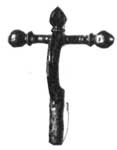
|
| Fig. 247 |
- This tomb was carved with the same skill and, perhaps, by the same maker as no. 986; pier of bedrock 0.17 m wide separated it from the previous tomb. The length and width of this tomb are the same, but it is 1.42 m deep; there were 2 niches below, at the footing, 0.26 m w<ide> in the west wall and 0,48 м w<ide> in the east wall. This tomb was also covered with 3 slabs, with the joints plustered with lime, and contained 2 skeletons: of a man (with the head to the s<outh>) and a child at the man’s leg (with the head to the w<est>). It is probable that niches in such graves were arranged so that child’s skeleton laid crosswise at the legs of the parent could be placed easily. At the head of the man’s skeleton, there were: 2 single-handled juglets; gol<d> impression of coin, of excellent preservation, with image of Roman eagle with inscription
 around, and big bronz<e> fibula covered with gilt, heavily damaged
(Fig. 247)
. At the waist, there were: small iron knife blade; bronz<e> belt buckle; and 4 bronz<e> coins from Chersonesos (Burachkov, <Op. cit., pl.> XVI, 106, 108, 110, 114). At the legs: 5 earthen<ware> single-handled juglets (two ribbed and 1 of ashy color); 3 earthen<ware> lamps (1 plain, 1 ribbed, with letters
around, and big bronz<e> fibula covered with gilt, heavily damaged
(Fig. 247)
. At the waist, there were: small iron knife blade; bronz<e> belt buckle; and 4 bronz<e> coins from Chersonesos (Burachkov, <Op. cit., pl.> XVI, 106, 108, 110, 114). At the legs: 5 earthen<ware> single-handled juglets (two ribbed and 1 of ashy color); 3 earthen<ware> lamps (1 plain, 1 ribbed, with letters
 on top, and 1 relief rosette with 24 petals and name of the maker,
on top, and 1 relief rosette with 24 petals and name of the maker,
 (Fig. 248,
249
; cf. the lamp from catacomb no. 888). Further finds: earthen<ware> bowl with piece of sulfur inside and 10 cup-shaped bells, of the form appeared for the first time
(Fig. 250)
, similar to the circle fragments from church candlesticks uncovered in 1891 in the altarless church on the eastern seashore, together with bronz<e> plate for fixing the candlesticks.
(Fig. 248,
249
; cf. the lamp from catacomb no. 888). Further finds: earthen<ware> bowl with piece of sulfur inside and 10 cup-shaped bells, of the form appeared for the first time
(Fig. 250)
, similar to the circle fragments from church candlesticks uncovered in 1891 in the altarless church on the eastern seashore, together with bronz<e> plate for fixing the candlesticks.

|

|
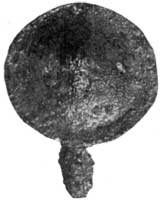
|
| Fig. 248 |
Fig. 249 |
Fig. 250 |
Although 3 bells keep iron clappers, no one has a loop on top (probably, these were of iron as well). The diameter at the base is as follows: of 3 bells 0.056 m each, 2 of 0.053 m each, and 3 of 0.05 m each, and 2 of 0.045 m. At the head of the child’s skeleton, there were: gold impression of coin imaging lion facing right; very rough earthen<ware> lamp; bone stick with hole that was used as a handle for toy bell; 24 round beads of multicolored glass; at the waist, there was silver expandable bracelet.

|
| Fig. 251 |
- This carved into bedrock tomb (2.15 m l<ong>, 0.62 m w<ide>, and 1,77 m d<eep>) is of the same quality as 2 tombs nos. 986 and 987 described above; it has niche in the east wall, near the footing (0.53 m w<ide> and 0.70 m h<igh>) and was covered with 2 thick slabs, above which there was strong wall of rubble mortared with lime, in the form of a platform 4.25 m l<ong> and 1.95 m w<ide>. There were two skeletons, of a man in the tomb and a girl in the niche, located close to each other, with the heads to the s<outh>. At the man’s skeleton, there were glass bottle ear the waist and ashy earthen<ware> lamp at the legs. At the child’s skeleton, there were: at the head, pair of gold earrings in the form of circular panel with massive ring
(Fig. 251)
and g<old> cut impression of coin with illegible image; at the waist, g<old> finger-ring (the stone, glass or enamel inset from the socket is missing); and at the legs, bottle in the form of decanter, decorated with bands closely located circles etched on glass.
- Earthen<ware> urn in the form of Greek double-handled pointed-bottom amphora laid sideways, so the soil crushed it. It contained bones of the baby that were not cremated (cf. nos. 908 and 970) and single-handled earthen<ware> cup.
- The catacomb (2.50 m l<ong>, 2.15 m w<ide>, and 1.60 m h<igh>) has 6 bed-shaped niches in 2 tiers and the entrance (0.62 х 0.57 m) from the e<ast>. The slab that covered the entrance was broken into 3 pieces; the joints were blocked with crushed stone and were not plastered with lime. There were 1 skeleton in each niche and 4 more skeletons on the floor, but neither coins, nor pottery, nor even shards. This circumstance and broken slab allow me to suppose that this ancient catacomb, that required a lot of work to construct it, was used by the residents of Byzantine Chersonesos.
- This carved into bedrock tomb was not covered and was plundered.
- This underground tomb appeared to contain single skeleton (with the head to s<outh>) and no grave goods.
In between of catacomb no. 981 amd tomb no. 986, at the depth of 0.70 m, there was plain rectangular platfоrm
(s<ee> the plan of the necropolis on fig. 225)
, ab<out> 5 m<eters> l<ong> and 1.60 m w<ide>, that appeared to be a wall, laid of excellent stone slabs (0.88 to 2.04 m l<ong> and 0.35 m th<ick>), in 2 lines, with lime mortar. Under these slabs was plain bedrock. They had to carve a pit of appropriate form into bedrock in order to construct this stone platform. It turned out that this platform was not grave grave monument; it undoubtedly had its own purpose, so it is possible to hypothesize that this rised area in the ancient necropolis housed a portico, marble parts of which were plundered in the Byzatine period. The following artifacts, that had no relation to the discovered tombs, were uncovered from the mound of the discussed necropolis in 1896 and the year under report: two fragments of Doric cornice (one is 0.85 m l<ong>, 0.40 m h<igh>, and 0.17 m th<ick>); fragment of round column, of sandstone; round base, of sandstone (0.93 m in diameter at the base), that covered the entrance to catacomb no. 789; fragment of marble cornice, 1.06 m l<ong>; fragment of plain marble slab; fragment of shoulder from big marble statue, and 0.29-m-long fragment of marble statue that probably depicted one of Heracles’s labors.

|
| Fig. 252 |
- -995. A layer of soil covering these three plundered catacombs did not exceed 0.35 m. The slabs from the emtrance were moved away, so a lot of soil penetrated inside the catacombs
[29]
. Each catacomb has 6 bed-shaped niched, in two tiers; all exits are oriented to the e<ast>. A great number of bones heaped in the niches and on the floor indicate that the catacombs are plundered. Removed and sieved soil contained 6 earrings in the form of plain bronz<e> rings, of the type usually uncovered from the tombs at churches (in no. 993 — 2 pieces, in no. 994 — 3 pieces, and in no. 995 — 1 piece). Besides these earrings, the last catacomb contained one more bronz<e> earring, damaged, in the form of small tap hanged to a ring
(Fig. 252)
. These 3 catacpmbs probably had ancient origin, similar to catacomb no. 990, but were plundered and fitted for burials of Christian period.
- This carved into bedrock tomb was not covered with slabs and was plundered; it is located above the south-west<ern> corner of catacomb no. 995.
- This carved into bedrock tomb was not covered with slabs and was plundered.
- -999. Two catacombs were plundered, so that the soil and the bones were collected separately and heaped in different corners. Door slab of catacomb 998 was leaned to the entrance hole, though the neighboring tomb had such barrier inside
[30]
. The soil, that was removed from catacomb no. 998 and sieved, contained: 4 fragments of jet ccircle (0.015 m w<ide>, 0.015 m th<ick>, and 0.062 m of inner diameter) with tooth-like cuts on either side and hole for hanging; bronz<e> coin of the emperor Constantius II (337-361). In the corner of the western niche in catacomb no. 999, there were 12 earthen<ware> lamps (10 had the same form and dimensions, theу were decorated with ribs; 2 were small and rough). The soil was sieved and appeared to contain nothing.
- This tomb (2.15 m l<ong>, 0.70 m w<ide>, and 0.80 m d<eep>) was carved into bedrock and partly covered with thick stone slab; the skeletons in it were in good state of preservation, but without coins and pottery, which allowed me to think that the burials belonged to Christians. At the footing of the tomb, there were: 2 big ir<on> buckles, possibly for mhorse trappings; ir<on> knife blade; and st<one> whetstone with hole for hanging.
- This catacomb (2.15 m l<ong> and w<ide>, and 1.42 m h<igh>) has 2 bed-shaped niches in the n<orth> and s<outh> walls and exit to the e<ast>; it was plundered. The slab from the entrance was found within the catacomb. Removed and sieved soil appeared to contain nothing.
- The catacomb (4.25 m l<ong>, 3.55 m w<ide>, and 1.60 m h<igh>) has 3 bed-shaped niches and entrance (0,70 м х 0,62 м) from the e<ast>; it was plundered, with partly collapsed ceiling. Grave robbers threw the bones фов soil out of the catacomb. Sieved soil contained oval medallion (0.043 х 0.037 m), consisting of plain carnelian framed with gold wreath with wide eyelet.
- This plundered tomb (2.15 m l<ong>, 0.62 m w<ide>, and 1.05 m d<eep>) is carved into bedrock. It was covered by one solid slab, carved in the form of pointed lid for sarcophagus, 2.35 m l<ong>, 0.80 m w<ide>, and 0.31 m high as maximum. As the grave robber was not able to move the lid, he made a hole in one side of it, through which he went into the tomb. On the floor, there were cremated bones from several skeletons and 5 broken earthen<ware> saucers with high feet. Outside the tomb, in front of the hole, there were 5 earthen<ware> lamps: 2 plain and 3 with relief image of eagle, sitting, and rosettes with 4 and 6 petals.
- This catacomb (3.55 m l<ong>, 2.85 m w<ide>, and 1.85 м h<igh>) has one niche in its s<outh> wall, tetrahedral supporting pillar in the middle, and exit (0.70 х 0.62 m) to the e<ast>. The bones were heaped on the floor and had no accompaniments. Removed and sieved soil contained: earthen<ware> lamp, rough, with image of Eros running to the right, and whetstone, bronek into pieces, with hole for hanging.
- Underground tomb. The skeleton laid with the head to e<ast> and appeared to be not accompanied.
- This carved into bedrock tomb was not covered with slabs and was plundered.
- Similar tomb. Removed soil contained: earthen<ware> single-handled juglet; bronz<e> expandable bracelet; slate tablet with the edges aslant on one side; bronz<e> stick with rounded end and spade, and bronz<e> coin of Chersonesos (Burachkov, <Op. cit., pl.> XVI, 91, but of smaller size).

|
| Fig. 253 |
- This underground tomb is 0.35 m below the surface level. At the skeleton with the head oriented to the s<outh>, there were: earthen<ware> vessel, of ashy color, in the form of tray with 2 wide handles, decorated with lines pressed into its surface
(Fig. 253)
; crushed crystal plates (it could be a tablet similar to the ones uncovered from catacombs nos. 888, 902 and 982 and tomb no. 1007); ir<on> lock (0.10 х 0.06 m), for a casket; iron knife blade; fragment of sil<ver> ear cleaner; and ir<on> cup-shaped circle, broken into two pieces, with image of Nike stepping right carved into its convex side.
The mound of the necropolis contained:
- grave slab, of local stone, with six-line Greek inscription. The end of the last line, with the age of the buried person, citizen of Heraclea, is missing
[31]
;
- fragment of top right corner of 5-line Greek inscription, that was located below some relief picture, carved in marble, of which only damaged paws and hoofs of some animals survived
[32]
; fragment of marble slab with fragment of Greek inscription, in two lines [33];
[33]
;
- fragment of marble cornice, 1.05 m l<ong>, with dowel hole;
- fragment of grave stele of yellowish sandstone, with a part of relief image of sword and bow, similar to the ones described in 1892 Otchёt <Arkheologicheskoy> Komissii (Archaeological Commission Report), p. 109, cat. no. 66;
- fragment of pediment, of sandstone, from ancient Greek grave stele;
- 13 quadrangular slabs of local stone, with carved rectangular slots for fixing pointed decorations of the same stone in horizontal position
[34]
;
- 11 stone poited decorations of this type;
- three handles of earthen<ware> amphorae, stamped;
- seven earthen<ware> sinkers for fishing nets in the form of truncated pyramids (one has illegible image in relief);
- black slip saucer, broken;
- earthen<ware> single-handled juglet;
- top fragment of earthen<ware> lamp, with relief image of gladiator, with lowered helmet and big quadrangular shield, walking to cypress tree on the right
(Fig. 254)
;
- terracotta statuette of genius, standing, with long lowered wings, wearing high headdress;
- small oval carnelian with carved symbol of alliance (handshaking);
- broken silv<er> ear cleaner, similar to the one uncovered from catacomb no. 888;
- one silv<er>
(Fig. 255)
and one bronz<e>
(Fig. 256)
belt buckles;
- plain silv<er> finger-ring;
- bronz<e> bracelet with pointed ends;
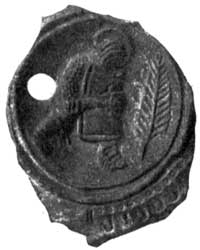
|

|

|
| Fig. 254 |
Fig. 255 |
Fig. 256 |
- silv<er> child’s bracelet of the same construction;
- bone awl;
- paste pierced bead of black color with yellow stripes;
- several bronz<e> coins of Chersonesos, and namely: 2 from the Greek period, 7 from the Roman period, 3 from the Byzantine period (of Justinian I, Basil I and Constantine Х);
- bronz<e> coin from Tyras, with the head of Demeter and bull, and with countermark in the shape of horse’s head in circle;
- colonial bronz<e> coin, illegible;
- bronz<e> coin from Sinope;
- sil<ver> coin of the emperor Titus (AD 79-81);
- bronz<e> late Roman coin (of the sixth century);
- human skull, slightly deformed;
- top fragment of deformed skull, heavily damaged;
- flint end scraper;
- obsidian whetstone;
- nucleus of very good preservation.
|


